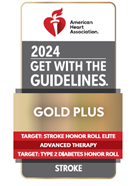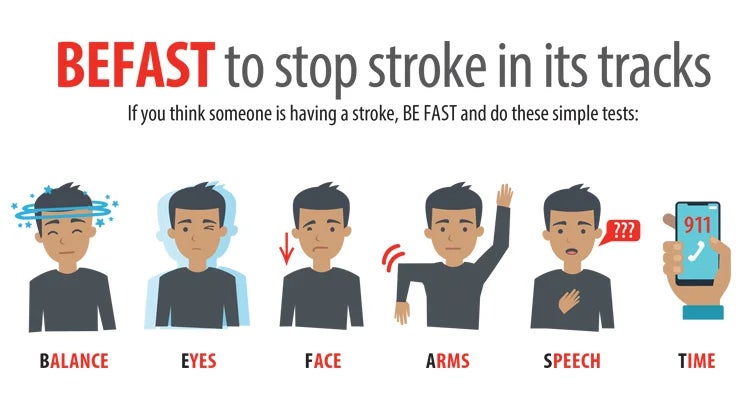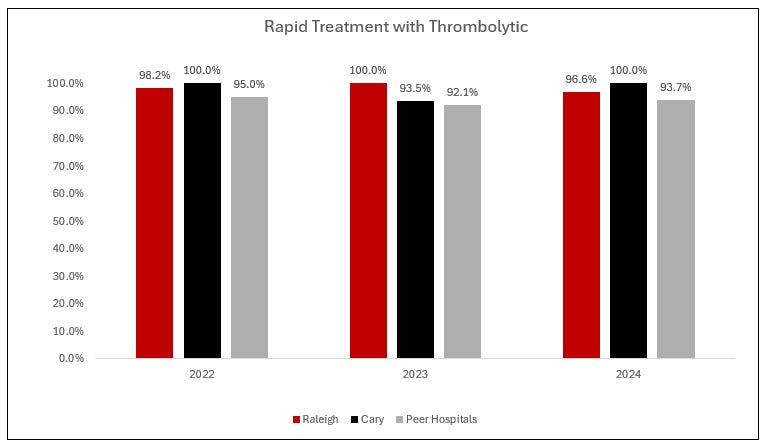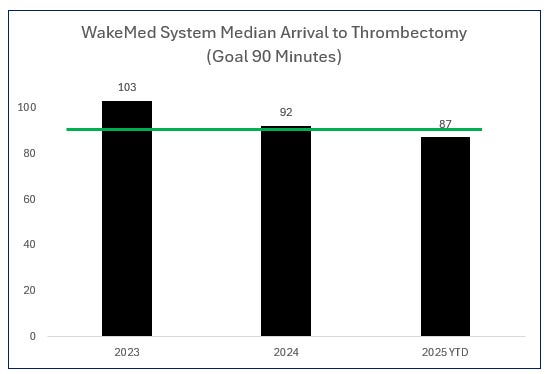Stroke Program
WakeMed's Award-Winning Stroke Program
Each year, thousands of families in our community are impacted by stroke — a brain attack that can occur at any age.
At WakeMed, our care team understands the greatest chance for recovery from stroke occurs when treatment is started immediately after the onset of symptoms. We offer a full continuum of compassionate stroke care — from diagnosis in our emergency departments, inpatient treatment, rehabilitation to innovative quality of life procedures in both our award-winning inpatient and outpatient facilities.
 WakeMed Raleigh Campus is Joint Commission-Thrombectomy Capable Stroke Center and WakeMed Cary Hospital is a Joint Commission-Certified Primary Stroke Center that also performs Thrombectomies. Both hospitals have received Get With The Guidelines®- Stroke Achievement awards. We’ve also received the Joint Commission Gold Seal of Approval for Stroke Care. WakeMed is also accredited by the Commission of Accreditation on Rehabilitation Facilities (CARF) and is Stroke Specialty Program Certified (CARF-SSP), due to our comprehensive inpatient rehabilitation programs and commitment to specialty rehab.
WakeMed Raleigh Campus is Joint Commission-Thrombectomy Capable Stroke Center and WakeMed Cary Hospital is a Joint Commission-Certified Primary Stroke Center that also performs Thrombectomies. Both hospitals have received Get With The Guidelines®- Stroke Achievement awards. We’ve also received the Joint Commission Gold Seal of Approval for Stroke Care. WakeMed is also accredited by the Commission of Accreditation on Rehabilitation Facilities (CARF) and is Stroke Specialty Program Certified (CARF-SSP), due to our comprehensive inpatient rehabilitation programs and commitment to specialty rehab.

B.E.F.A.S.T. to Detect a Stroke
If you think someone is having a stroke, look for these FAST signs:
Balance - Is the person losing his/her coordination or balance? Is he/she having trouble walking?
Eyes - Is the person having trouble seeing out of one or both eyes?
Face - Does the face look uneven? Ask the person to smile.
Arm - Does one arm drift down? Ask the person to raise both arms.
Speech - Does his or her speech sound strange? Ask the person to answer a simple question.
Time - If you observe any of these signs, then it's time to call 9-1-1.
When it's a stroke, time is of the essence. The quicker you can get a stroke victim to the hospital, the better his/her chances for recovery.
If you suspect stroke, don’t wait! Stroke treatments are time sensitive. Call 911 immediately for transport to the emergency department.

This chart shows the percentage of patients who arrive within two hours of their “Last Known Well” and receive the clot busting medication within three hours of their last known well. WakeMed consistently performs above Peer Hospitals nationwide.
The “Last Known Well” is a critical timeframe that the care team uses to determine stroke onset and treatment eligibility, as the clot busting medication (thrombolytic) can only be used within 4.5 hours of stroke onset.
In 2024, 79 percent of ischemic stroke patients who arrived to the hospital within 4.5 hours of stroke symptom onset and received Tenecteplase (with or without Thrombectomy) were able to either discharge home or to Inpatient Rehab.

Every minute counts when it comes to stroke, and it is critical for our patients to have access to treatment as quickly as possible to save as much brain tissue as possible. The AHA recommends a goal from patient arrival to the ED to receiving a thrombectomy of 90 minutes. WakeMed continues to improve our times and increase patient access to this care.
Patients with large strokes have historically required discharge to skilled nursing facilities after their hospital stay. This has changed dramatically in the past decade thanks to the availability of thrombectomies, or clot-retrieval procedures, that allow specialized teams to remove the clot from your brain!